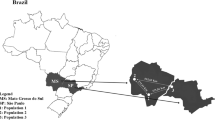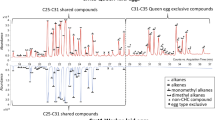Abstract
Cuticular hydrocarbons are used by some ants to discriminate nestmates from nonnestmates. Every member of the colony bears the same pattern because they are continuously exchanged among nestmates. The postpharyngeal gland (PPG) stores the blend of hydrocarbons and is involved in the distribution of this common mixture. However, some individuals might display individual information on the cuticle (such as a chemical signal of fertility) that must not be mixed within the common pool. We investigated how this paradox is solved in the ant Pachycondyla goeldii by analyzing the nature and localization of colonial and fertility signals. Workers in a queenless condition showed a dominance hierarchy that was correlated with ovarian development. Hydrocarbons from the cuticle and the PPG analyzed by gas chromatography (GC) and identified by GC-mass spectrometry showed a clear discrimination among colonies, supporting the involvement of the PPG in the colonial identity signal. We identified and selected 11 cuticular hydrocarbons that permitted us to discriminate ovarian development classes and that might function as a fertility signal. They allowed clear colony discrimination as well, which suggests that the two signals (the individual signal of fertility and the common signal of colony identity) can be conveyed by the same compounds. However, the hydrocarbons in the PPG did not discriminate among ovarian developmental classes, suggesting that the portion of variation in the cuticular hydrocarbons constituting the fertility signal is superimposed on the signal of colony identity.





Similar content being viewed by others
References
Aitchison, J. 1986. The Statistical Analysis of Compositional Data: Monographs in Statistics and Applied Probability. Chapman and Hall, London.
Bagneres, A. G. and Morgan, E. D. 1991. The postpharyngeal gland and the cuticle of Formicidae contain the same hydrocarbons. Experientia 47:106–111.
Bonavita-Cougourdan, A., Clément, J. L., and Lange, C. 1987. Nestmate recognition: The role of cuticular hydrocarbons in the ant Camponotus vagus Scop. J. Entomol. Sci. 22:1–10.
Bonavita-Cougourdan, A., Clément, J. L., and Lange, C. 1993. Functional subcaste discrimination (foragers and brood-tenders) in the ant Camponotus vagus Scop.: Polymorphism of cuticular hydrocarbon patterns. J. Chem. Ecol. 19:1461–1477.
Carlin, N. F. and Hölldobler, B. 1986. The kin recognition system of carpenter ants (Camponotus spp.). I. Hierarchical cues in small colonies. Behav. Ecol. Sociobiol. 19:123–134.
Carlin, N. F. and Hölldobler, B. 1987. The kin recognition system of carpenter ants (Camponotus spp.). II. Larger colonies. Behav. Ecol. Sociobiol. 20:209–217.
Crosland, M. W. J. 1989. Kin recognition in the ant Rhytidoponera confusa. II. Gestalt odour. Anim. Behav. 37:920–926.
Crozier, R. H. 1987. Genetic aspects of kin recognition: Concepts, models, and synthesis, pp. 55–73, in D. J. C. Fletcher and C. D. Michener (eds.). Kin Recognition in Animals. Wiley, New York.
Crozier, R. H. and Dix, M. W. 1979. Analysis of two genetic models for the innate components of colony odor in social Hymenoptera. Behav. Ecol. Sociobiol. 4:217–224.
Cuvillier-Hot, V., Cobb, M., Malosse, C., and Peeters, C. 2001. Sex, age and ovarian activity affect cuticular hydrocarbons in Diacamma ceylonense, a queenless ant. J. Insect. Physiol. 47:485–493.
Cuvillier-Hot, V., Lenoir, A., Crewe, R., Malosse, C., and Peeters, C. 2004a. Fertility signalling and reproductive skew in queenless ants. Anim. Behav. 68:1209–1219.
Cuvillier-Hot, V., Lenoir, A., and Peeters, C. 2004b. Reproductive monopoly enforced by sterile police workers in a queenless ant. Behav. Ecol. 15:970–975.
Dahbi, A. and Lenoir, A. 1998. Nest separation and the dynamics of the Gestalt odor in the polydomous ant Cataglyphis iberica (Hymenoptera, Formicidae). Behav. Ecol. Sociobiol. 42:349–355.
D’ettorre, P., Heinze, J., Schulz, C., Francke, W., and Ayasse, M. 2004. Does she smell like a queen? Chemoreception of a cuticular hydrocarbon signal in the ant Pachycondyla inversa. J. Exper. Biol. 207:1085–1091.
Dietemann, V., Peeters, C., Liebig, J., Thivet, V., and Hölldobler, B. 2003. Cuticular hydrocarbons mediate discrimination of reproductives and nonreproductives in the ant Myrmecia gulosa. Proc. Natl. Acad. Sci. U.S.A. 100:10341–10346.
Do Nascimento, R. R., Billen, J., and Morgan, E. D. 1993. The exocrine secretions of the jumping ant Harpegnathos saltator. Comp. Biochem. Physiol. B 104:505–508.
Hadley, N. F. 1994. Water Relations of Terrestrial Arthropods. Academic Press, San Diego.
Hannonen, M., Sledge, M. F., Turillazzi, S., and Sundström, L. 2002. Queen reproduction, chemical signalling and worker behaviour in polygynous colonies of the ant Formica fusca. Anim. Behav. 64:477–485.
Hefetz, A., Soroker, V., Dahbi, A., Malherbe, M. C., and Fresneau, D. 2001. The front basitarsal brush in Pachycondyla apicalis and its role in hydrocarbon circulation. Chemoecology 11:17–24.
Heinze, J., Trunzer, B., Oliveira, P. S., and Hölldobler, B. 1996. Regulation of reproduction in the neotropical ponerine ant, Pachycondyla villosa. J. Insect Behav. 9:441–450.
Heinze, J., Stengl, B., and Sledge, M. F. 2002. Worker rank, reproductive status and cuticular hydrocarbon signature in the ant, Pachycondyla cf. inversa. Behav. Ecol. Sociobiol. 52:59–65.
Hölldobler, B. and Wilson, E. O. 1990. The Ants. Belknap Press, Cambridge.
Ito, F. and Higashi, S. 1991. A linear dominance hierarchy regulating reproduction and polyethism of the queenless ant Pachycondyla sublaevis. Naturwissenschaften 78:80–82.
Kaib, M., Eisermann, B., Schoeters, E., Billen, J., Franke, S., and Francke, W. 2000. Task-related variation of postpharyngeal and cuticular hydrocarbon composition in the ant Myrmicaria eumenoides. J. Comp. Physiol. A Sens. Neural. Behav. Physiol. 186:939–948.
Lahav, S., Soroker, V., Hefetz, A., and Vander Meer, R. K. 1999. Direct behavioral evidence for hydrocarbons as ant recognition discriminators. Naturwissenschaften 86:246–249.
Lenoir, A., Fresneau, D., Errard, C., and Hefetz, A. 1999. Individuality and colonial identity in ants, pp. 219–237, in C. Detrain, J. L. Deneubourg, and J. Pasteels (eds.). Information Processing in Social Insects. Birkhäuser Verlag, Basel.
Liebig, J., Peeters, C., Oldham, N. J., Markstadter, C., and Hölldobler, B. 2000. Are variations in cuticular hydrocarbons of queens and workers a reliable signal of fertility in the ant Harpegnathos saltator? Proc. Natl. Acad. Sci. U.S.A. 97:4124–4131.
Lucas, C., Pho, D. B., Fresneau, D., and Jallon, J. M. 2004. Hydrocarbon circulation and colonial signature in Pachycondyla villosa. J. Insect. Physiol. 50:595–607.
Meskali, M., Bonavita-Cougourdan, A., Provost, E., Bagneres, A. G., Dusticier, G., and Clément, J. L. 1995. Mechanism underlying cuticular hydrocarbon homogeneity in the ant Camponotus vagus (Scop.) (Hymenoptera: Formicidae): Role of postpharyngeal glands. J. Chem. Ecol. 21:1127–1148.
Monnin, T., Malosse, C., and Peeters, C. 1998. Solid-phase microextraction and cuticular hydrocarbon differences related to reproductive activity in queenless ant Dinoponera quadriceps. J. Chem. Ecol. 24:473–490 [Erratum: Aug 1998, v. 24 (8), p. 1423.].
Ozaki, M., Wada-Katsumata, A., Fujikawa, K., Iwasaki, M., Yokohari, F., Satoji, Y., Nisimura, T., and Yamaoka, R. 2005. Ant nestmate and non-nestmate discrimination by a chemosensory sensillum. Science 309:311–314.
Peeters, C. 1991. Ergatoid queens and intercastes in ants: Two distinct adult forms which look morphologically intermediate between workers and winged queens. Insect Soc. 38:1–15.
Peeters, C., Monnin, T., and Malosse, C. 1999. Cuticular hydrocarbons correlated with reproductive status in a queenless ant. Proc. R. Soc. Lond. B 266:1323–1327.
Schal, C., Sevala, V. L., Young, H. P., and Bachmann, J. A. S. 1998. Sites of synthesis and transport pathways of insect hydrocarbons: Cuticle and ovary as target tissues. Am. Zool. 38:382–393.
Schal, C., Sevala, V., Capurro, M. D. L., Snyder, T. E., Blomquist, G. J., and Bagneres, A. G. 2001. Tissue distribution and lipophorin transport of hydrocarbons and sex pheromones in the house fly, Musca domestica. J. Insect Sci. 1–12.
Soroker, V., Vienne, C., Hefetz, A., and Nowbahari, E. 1994. The postpharyngeal gland as a “Gestalt” organ for nestmate recognition in the ant Cataglyphis niger. Naturwissenschaften 81:510–513.
Soroker, V., Fresneau, D., and Hefetz, A. 1998. Formation of colony odor in ponerine ant Pachycondyla apicalis. J. Chem. Ecol. 24:1077–1090.
Soroker, V. and Hefetz, A. 2000. Hydrocarbon site of synthesis and circulation in the desert ant Cataglyphis niger. J. Insect. Physiol. 46:1097–1102.
Soroker, V., Lucas, C., Simon, T., Fresneau, D., Durand, J. L., and Hefetz, A. 2003. Hydrocarbon distribution and colony odour homogenisation in Pachycondyla apicalis. Insect. Soc. 50:212–217.
Stuart, R. J. 1988. Collective cues as a basis for nestmate recognition in polygynous leptothoracine ants. Proc. Natl. Acad. Sci. U.S.A. 85:4572–4575.
Thomas, M. L., Parry, L. J., Allan, R. A., and Elgar, M. A. 1999. Geographic affinity, cuticular hydrocarbons and colony recognition in the Australian meat ant Iridomyrmex purpureus. Naturwissenschaften 86:87–92.
Tsuji, K. 1990. Kin recognition in Pristomyrmex pungens (Hymenoptera: Formicidae): Asymmetrical change in acceptance and rejection due to odour transfer. Anim. Behav. 40:306–312.
Vander Meer, R. K. and Morel, L. 1998. Nestmate recognition in ants, pp. 79–103, in R. K. Vander Meer, M. Breed, M. Winston, and K. E. Espelie (eds.). Pheromone Communication in Social Insects. Westview Press, Boulder, CO.
Wagner, D., Tissot, M., Cuevas, W., and Gordon, D. M. 2000. Harvester ants utilize hydrocarbons in nestmate recognition. J. Chem. Ecol. 26:2245–2257.
Acknowledgments
We are grateful to Pr. A. Hefetz for identification of hydrocarbons by GC/MS and to Jeremy Bono for correcting the English text. The experiments were conducted in accordance with the current laws of France to the best of the authors’ knowledge.
Author information
Authors and Affiliations
Corresponding author
Rights and permissions
About this article
Cite this article
Denis, D., Blatrix, R. & Fresneau, D. How an Ant Manages to Display Individual and Colonial Signals by Using the Same Channel. J Chem Ecol 32, 1647–1661 (2006). https://doi.org/10.1007/s10886-006-9099-7
Received:
Revised:
Accepted:
Published:
Issue Date:
DOI: https://doi.org/10.1007/s10886-006-9099-7




